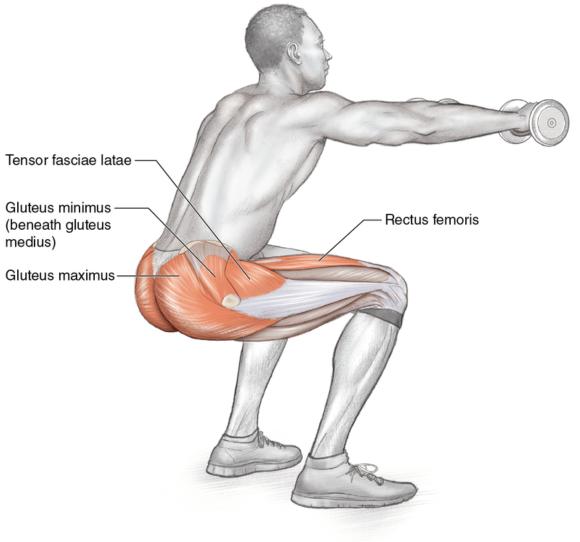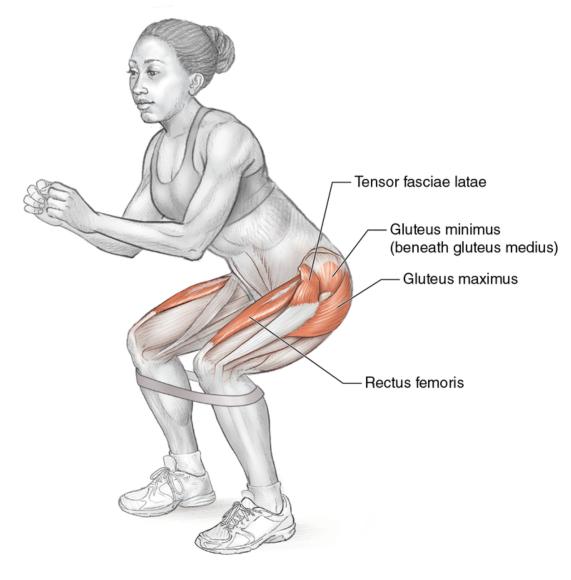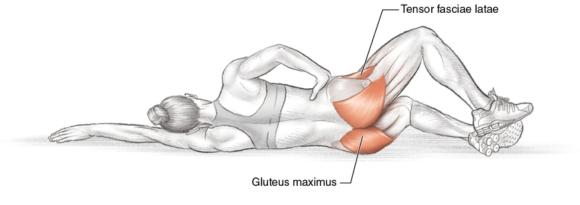|
Ligament Dominance
This is an excerpt from Basketball Anatomy by Chicago Bulls team physician Dr. Brian Cole and USA Strength and Conditioning Coaches Hall of Famer Rob Pannariello.
|

Neuromuscular Imbalance Pattern I: Ligament Dominance
The ligament dominance pattern, or the dynamic valgus, is the knock-knee position. To avoid this dangerous movement pattern, you need to strengthen your lateral hip muscles. Following are three exercises addressing ligament dominance.
Band Squat

Execution
- Place an elastic band just below both knees. Base the resistance on your ability to maintain both legs shoulder-width apart and knees in good alignment.
- Perform a squat until the thighs are parallel to the floor. While in the bottom position of the squat, continue to apply outward tension to the band, activating the gluteus medius and gluteus minimus.
Muscles Involved
- Primary: Quadriceps (rectus femoris, vastus lateralis, vastus medialis, vastus intermedius), gluteus medius, gluteus minimus
- Secondary: Tensor fasciae latae, hamstrings (semitendinosus, biceps femoris, semimembranosus)
Basketball Focus
The band squat develops hip strength for stabilizing yourself when cutting and changing direction. If you are a beginner, start with the lightest resistance band and progress to more resistance as strength develops. As with performing squats, proper foot position and attention to knee placement are important in this exercise.
Band Defensive Slide

Execution
- Place an elastic band around both knees. Starting in a good defensive position, maintain enough tension in the band so there is no slack.
- Take a defensive slide with one leg, increasing the tension on the band. Once you reach maximum tension based on your strength level, bring the other leg over to return to a good defensive position.
- Perform this pattern for the required distance or repetitions.
- Repeat the procedure moving in the other direction.
Muscles Involved
- Primary: Quadriceps (rectus femoris, vastus lateralis, vastus medialis, vastus intermedius), gluteus medius, gluteus minimus
- Secondary: Tensor fasciae latae, hamstrings (semitendinosus, biceps femoris, semimembranosus)
Basketball Focus
This exercise mimics a defensive slide performed in basketball. You can perform this exercise while holding your arms out as if you were defending against an opponent. As stated in the band squat exercise, this exercise helps to develop strength in the hips. Strength in the hips and gluteals is important, especially for female basketball players, in stabilizing the lower leg when pivoting and cutting.
Side-Lying Clam

Execution
- Place an elastic band just above both knees. Lie on your side with knees and hips flexed to about 90 degrees. The head, shoulder, knee, and ankle should be in a straight line.
- While maintaining a good side-lying position, separate the knees and rotate the top leg out, creating tension in the band. Return to the starting position.
- Perform the prescribed number of repetitions and switch sides.
Muscles Involved
- Primary: Gluteus medius, gluteus minimus, tensor fasciae latae, piriformis, obturator externus, quadratus femoris
- Secondary: Sartorius
Basketball Focus
This exercise develops gluteal and hip strength. When performing this exercise, avoid excessive rotation of the upper body. Maintain a straight line from head to shoulders, knees, and ankles. As you rotate the top leg, the feet do not come apart; all the motion is at the hip. 
|
|